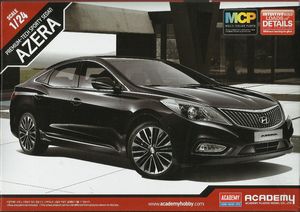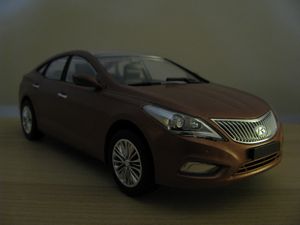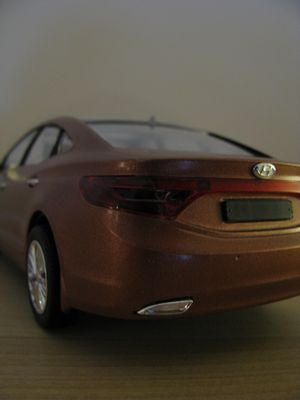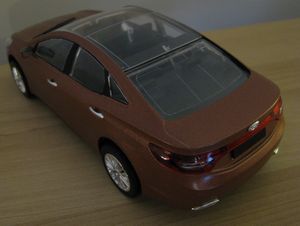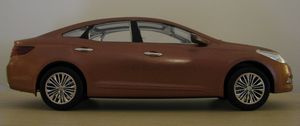|
By accessing or using The Crittenden Automotive Library™/CarsAndRacingStuff.com, you signify your agreement with the Terms of Use on our Legal Information page. Our Privacy Policy is also available there. |

Kit Review: Academy Hyundai Azera
|
|---|
|
|
| Opinions expressed by Bill Crittenden are not official policies or positions of The Crittenden Automotive Library. You can read more about the Library's goals, mission, policies, and operations on the About Us page.
|
Kit Review: Academy Hyundai Azera
Bill Crittenden
January 29, 2015
Academy kit #15121
Scale: 1:24
Imported by Model Rectifier Corp.
I'll start this off by saying that I've been waiting since about 2003 for someone to make a Hyundai model kit. Naysayers said it would never happen, but I knew someday it would even if I had to enter the business and make the damned thing myself.
Thankfully, Academy did it for me. And what a job they did! The Azera is a molded-in-color (as long as you wanted plain black on black) snap kit that was made with such precision that it was impossible not to finish my first complete model since 2006.
I wasn't interested in a plain black car, so I went with what I had on hand that seemed to fit the style, in this case Dodge's 1969-1971 era Dark Bronze Metallic (Testor's Model Master Lacquer). On a muscle car, it added a touch of class to something most commonly seen in wild bright candy colors or a bad ass black, but it also works well in the modern era where shades of bronze and brown are making a bit of a comeback on luxury cars.
First off, the trees! Finding parts on the tree is simplified by a handy parts location guide included with the instructions. Pulling them off requires little effort and leaves almost no excess plastic from the spot where the tree meets the part. It's annoying as heck to have to hack pieces off of a roughly made tree and then grind off the excess plastic, and even more annoying when it's on a chrome part that can't be easily re-chromed.
Academy really did a precision job on these that made building the car far less annoying and more enjoyable.
As for assembly, instructions were clear, logical, and the model fit together with just a few minor issues. One, if you've got fat fingers like me, you're going to need needlenose pliers for the shift lever. Two, DO NOT put the mirrors on the body before installing the windows!
The lights have clear lenses over chrome inserts to better mimic the style of the Azera's actual headlights. You have to pay attention to how the clear headlight lenses are installed, there's a part that wraps over the body before the rest goes inside the body, and it takes a bit of finger gymnastics to make it work. If you don't notice the part that goes outside of body in the instructions they'll never install correctly.
The black plastic does just fine for the almost-black dark grey interior on the real car, but if you want to get fancy on the interior you can paint it to match the two-tone interior. There are chrome inserts for the door handles as well as stickers and decals for the window switches.
Yes, stickers AND decals are included with this kit, so depending on the skill of the builder and the amount of effort you want to put into it, you have your options. Also optional is the type of roof: you can see the interior through the panoramic glass roof included with the kit or just install a plain metal roof, both are included.
Another unexpected option (if you don't know the car's history) is whether or not you want to label the car Azera (United States market) or Grandeur (Korean domestic market).
A little history note here: if you've seen this kit and wondered "why the Azera?" the current car is the fifth generation of Hyundai Grandeur, first produced for two generations in Korea as a rebadged Mitsubishi Debonair from 1986-1997. The third generation was Hyundai's first self-developed Grandeur, which began production for the 1998 model year and made its appearance in the American market in 2001 as the XG300. As of the fourth generation it shares platforms with the Sonata as basically a bigger and more luxurious version of that car. In this way its most similar competition, as far as I can tell, is the Toyota Avalon.
So while it's relatively new and obscure to us here in America, it's a fond old friend in Asia. Damned if I know what "Azera" means, though. I think they thought that "Grandeur" was a bit of an overreach for a car that was now going to share roads with big-ass Cadillac SUVs. If so, I wholeheartedly agree.
This kit is the type of model that doesn't include an opening engine or trunk, and the underside is pretty basic. I left my interior pretty basic so as not to get bogged down in the minutiae that always seems to keep me from finishing these models, but there are plenty of options for tricking out an interior for a show-quality build and the panoramic glass roof is perfect for showing them off. It seems the only omission from the kit for simplification that a skilled builder could really set themselves apart by adding is the chrome stripe that runs from under the headlight, across the fender, and under the side windows.
For a snap kit it's really tightly fit together without any rattles or loose parts. Which is pretty awesome, considering the kind and quality of car I was able to build without gluing my fingers together. It's not the kind of car someone takes to a cruise night and pops the hood up on, so I'm not too sad about missing the kind of mechanical details that are glue-kit only.
Oh, and the car rolls on its wheels, in case that sort of thing is important to you.
Hyundai started to make an appearance in scale hobbies here with the introduction of a Hot Wheels concept car and Tiburon almost ten years ago. Overseas it looks like there are some more small scale die cast cars available, but nothing else yet in the way of 1:24 plastic models. As Hyundai and Kia build a loyal customer base the world over, and with a revived motorsports program including Thierry Neuville winning the German round of the WRC in a Hyundai i20, we'll start to see more from this manufacturer make inroads into all types of hobbies, including plastic models.
With the win Neuville's i20 seems the likely next candidate for a company like Tamiya to turn out, but Hyundai race cars also include Rhys Millen's Global Rallycross Veloster and Pikes Peak Genesis Coupé. As for a street vehicle with customization options for the modeler, the Genesis Coupé seems the most likely candidate to see production. The original Genesis Coupé came in a lime green that Hyundai actually had the chutzpah to call "Lime Rock Green." And I've got a can of metallic lime green paint that would be
perfect for it.
Until then, I'd like to thank Academy for letting me check a box off of my car nerd bucket list (and thanks to John Walczak for buying the kit...Happy Birthday to me!), and for making doing so an easy and enjoyable process!

















